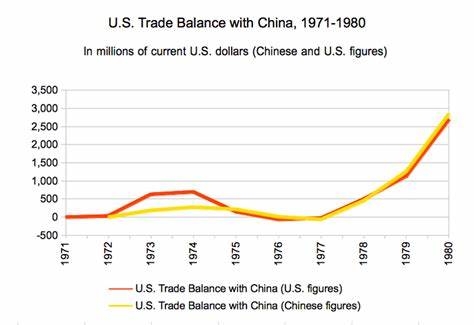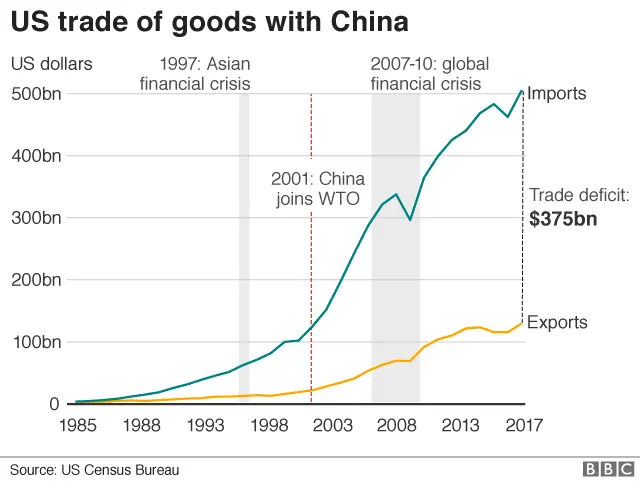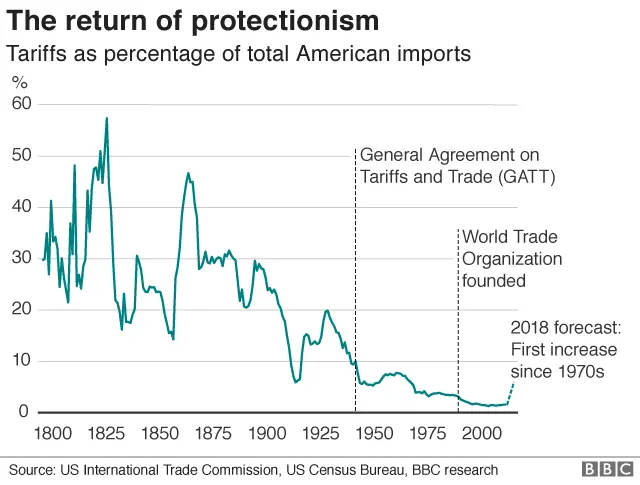Richard Nixon’s Visit to China: The Turning Point in Sino-American Relations that Forever Reshaped the Geopolitical Landscape of the World
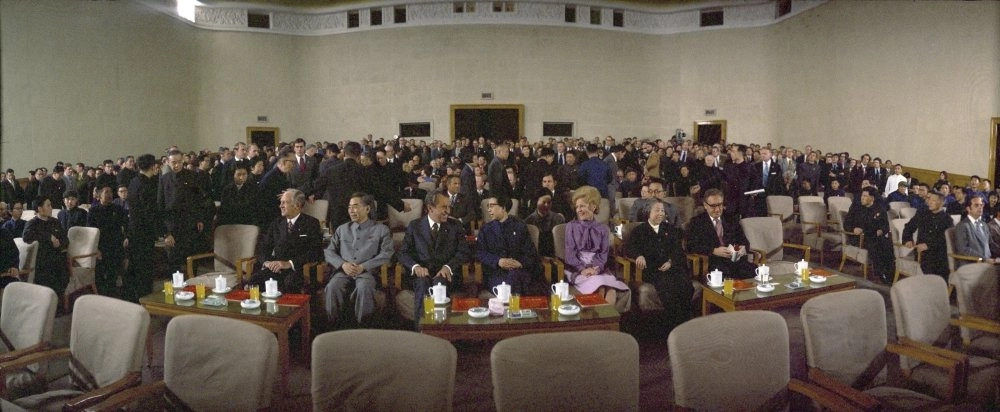
US delegation at the "The Red Detachment of Women" film, 1972, Richard Nixon Library
This week of diplomacy played a crucial role in warming tensions between not only the United States and China, but China and the world.
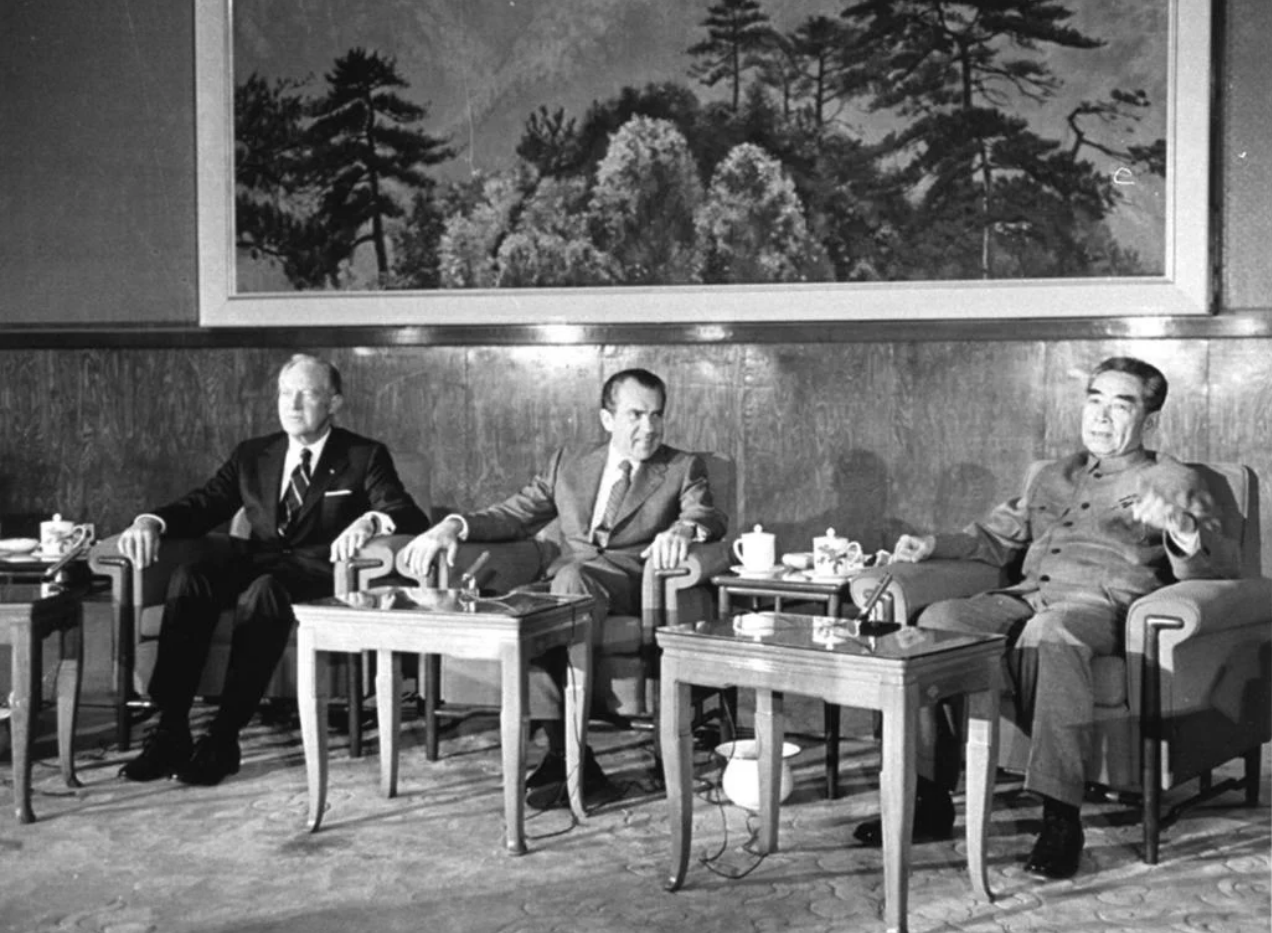
"President Nixon and Premier Zhou Enlai meet in Peking, February 21, 1972, for the start of talks after Nixon flew from Guam and Shanghai. At left is U.S. Secretary of State William Rogers." AP Photo
“I think that our two peoples and our two governments have established a very unique relationship which is founded on principle and in which we understand each other’s over-all approach in an unusual and complete manner. We have agreed that we were brought together by mutual necessity but since then we have built on this foundation, on a basis of candor and honesty, and a long range view. There is no leader with whom we speak as comprehensively as with the Prime Minister.”
-Henry Kissinger's Memorandum relfecting his conversations with Chinese Officials, 1973
Shortly after Nixon’s visit, other countries began establishing official political ties aswell. These relationships increased global cooperation and exchange.
New Zealand
China and New Zealand established diplomatic relations in 1972. New Zealand was the first country to support China's entry into the World Trade Organization.
"The Government of the People's Republic of China and the Government of New Zealand, in accordance with the principles of mutual respect for sovereignty and territorial integrity, non-interference in each other's internal affairs, and equality and mutual benefit, have decided upon mutual recognition and the establishment of diplomatic relations with effect from 22 December 1972.-
-Joint Communique on the Establishment of Diplomatic Relations Between the People's Republic of China and New Zealand
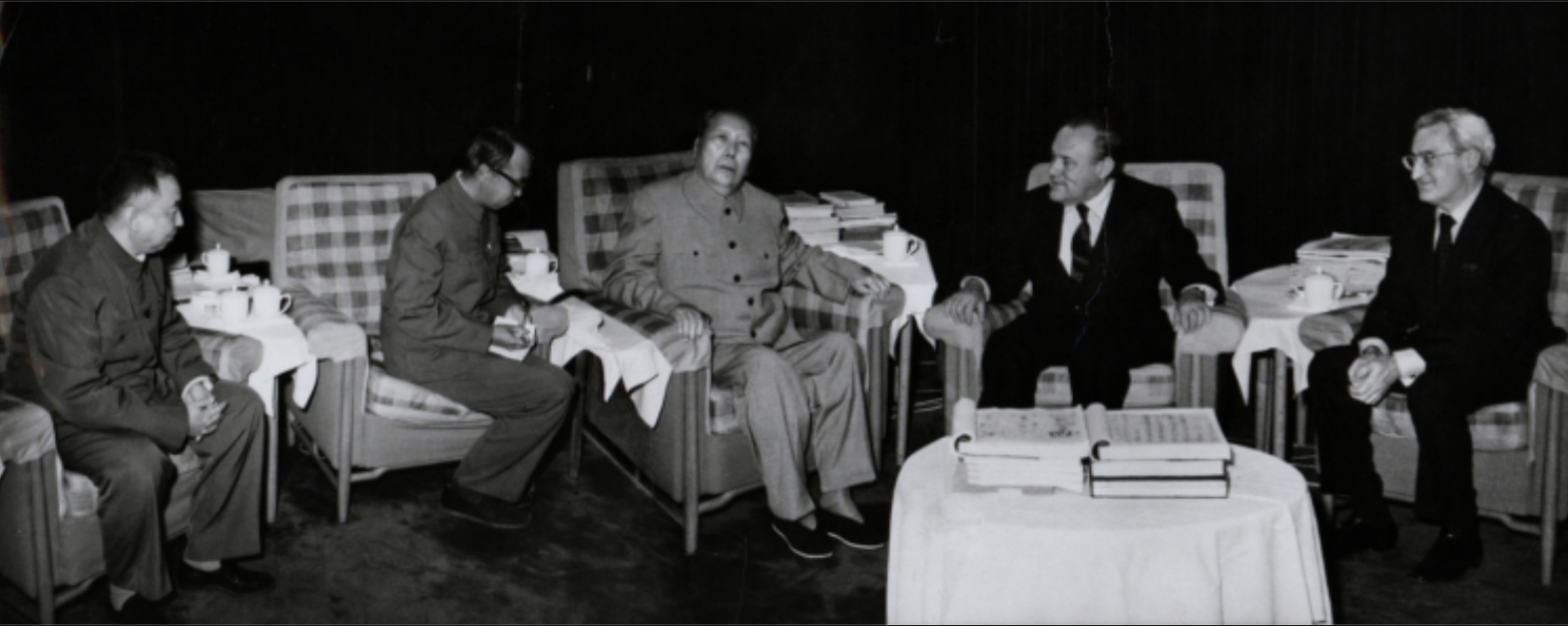
"Mao Zedong meeting with the New Zealand Delegation, in 1971." New Zealand Foreign Affairs and Trade
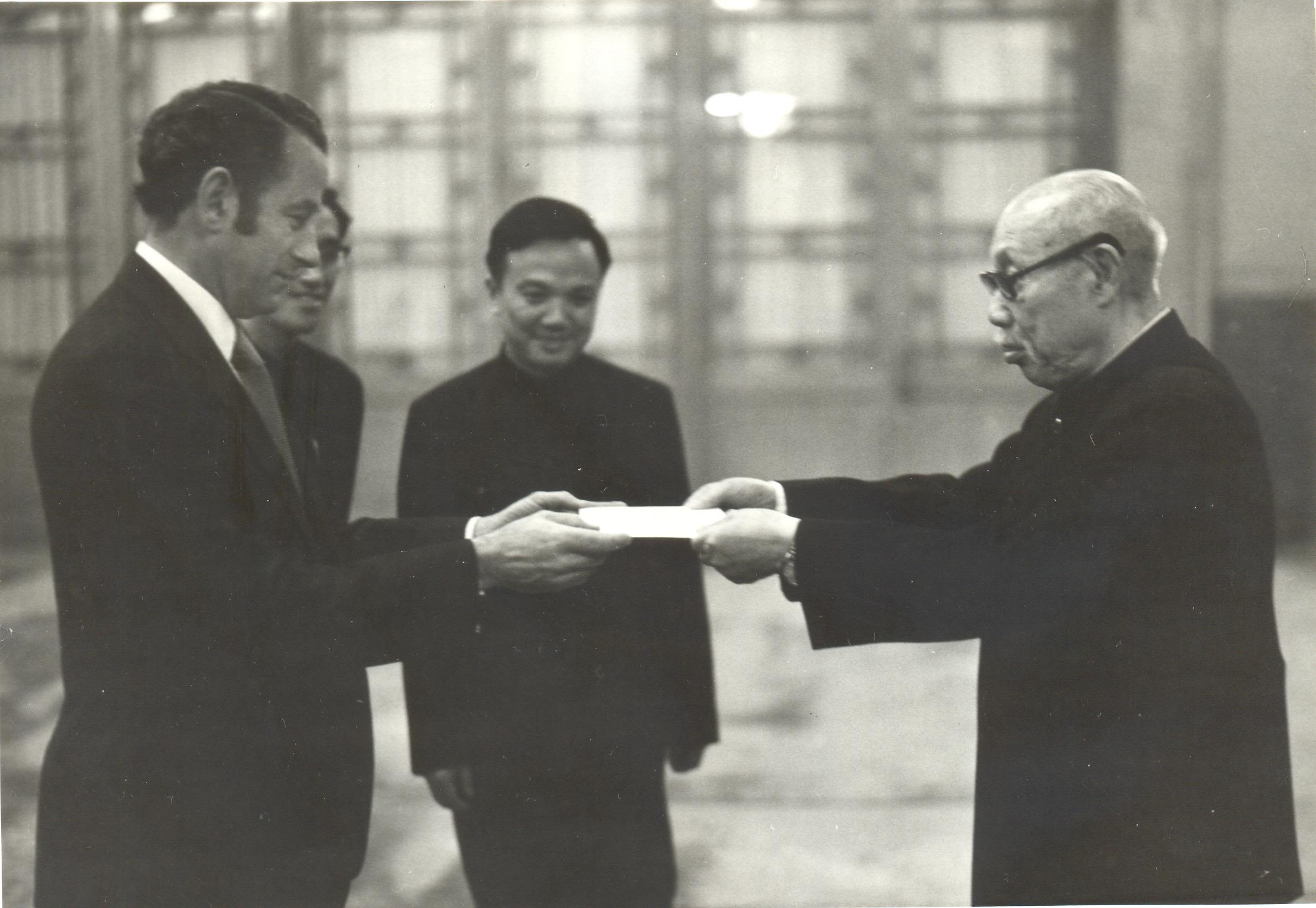
"New Zealand's first ambassador to China Bryce Harland presents his credentials to Acting President of China Dong Biwu, 1973." Ministry of Foreign Affairs
The two sides reaffirmed the importance of the 1972 Joint Communique on the Establishment of Diplomatic Relations and the 2014 Joint Statement on the Establishment of a Comprehensive Strategic Partnership between China and New Zealand. The two sides agreed to build on the 50th anniversary of diplomatic relations to strengthen high-level contacts, reinforce cooperation, build understanding, and manage differences.
-Joint Statement between New Zealand and the People’s Republic of China on the Comprehensive Strategic Partnership, 2023
Australia
Australia's recognition of the PRC marked acknowledgment of China's growing global importance. Australia was the first country after the U.S to establish official relations.
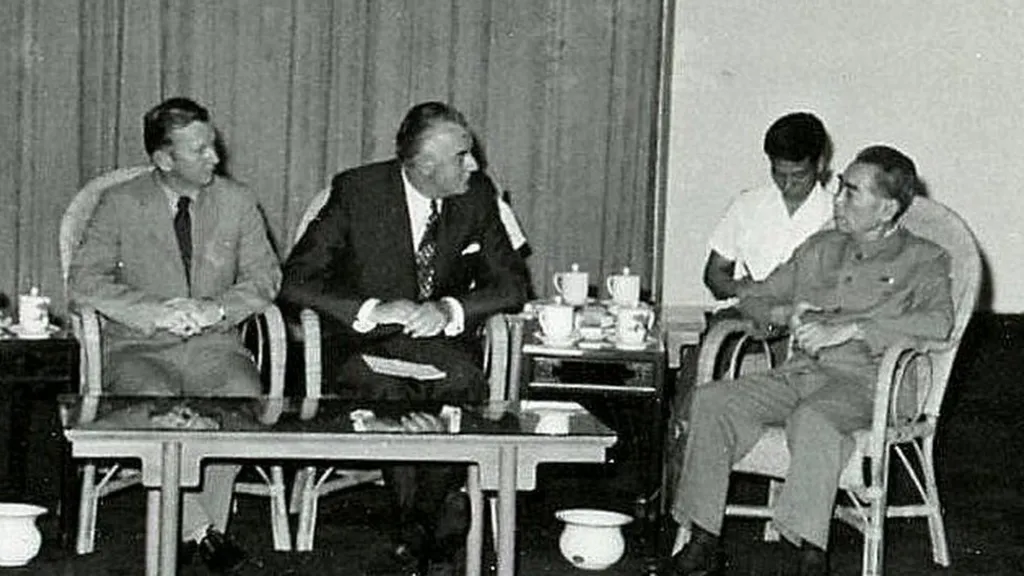
"Gough Whitlam (second from left) speaking with Zhou Enlai (right)" Stephen Fitzgerald

"Gough Whitlam met Chairman Mao Zedong in 1973." National Archives of Australia
“While it has long been recognised that Australia’s geographical position gives it special interests in the Asian region, up until now we have not come to terms with one of the central facts of that region, the People’s Republic of China. This serious distortion in our foreign policy has now been corrected.”
-Gough Whitlam, Australian Prime Minister
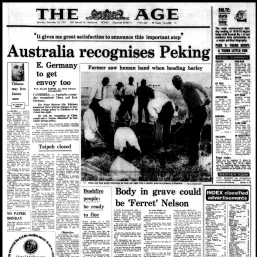
[The Age Australia]

"Stephen FitzGerald (right) and former Australian prime minister Gough Whitlam meet Chairman Mao Zedong on Nov 2, 1973, in Beijing." China Daily
“The Australian Government recognizes the Government of the People's Republic of China as the sole legal Government of China, acknowledges the position of the Chinese Government that Taiwan is a province of the People's Republic of China.
-Joint Communique between Australia and China, 1972
United Kingdom
Britain was one of the first nations to seek relations with China after Nixon's visit. These ties lead to the eventual Sino-British Joint Declaration in 1982.
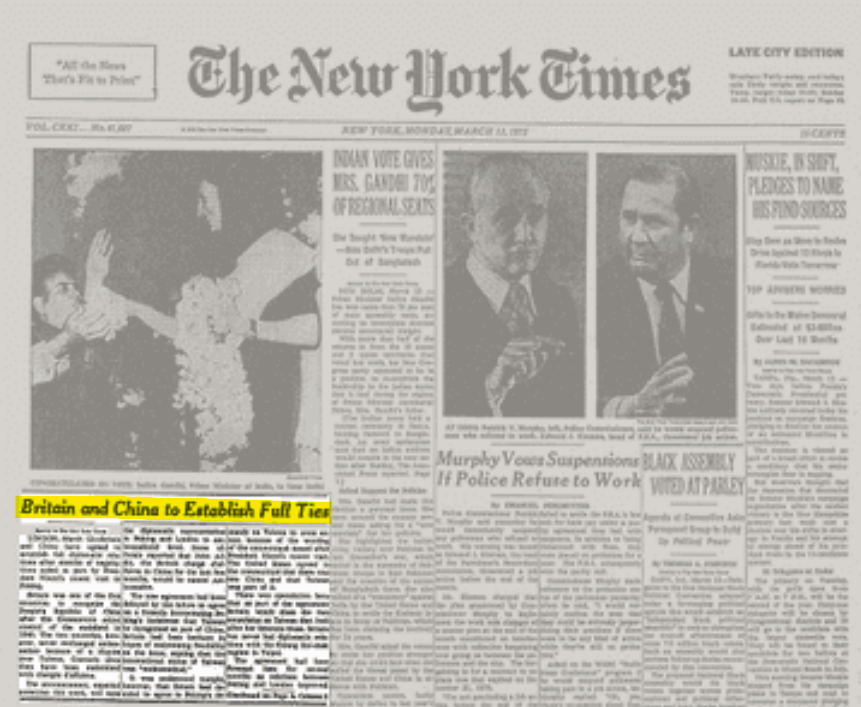
[The New York Times Archives, March 13, 1972]
"The Government of the People's Republic of China and the Government of the United Kingdom have decided to raise the level of their respective diplomatic representatives in each other's capitals from charges d'affaires to ambassadors as from March 13, 1972."
-Communiqué of the United Kingdom of Great Britain and of the People's Republic of China on an exchange of Ambassadors
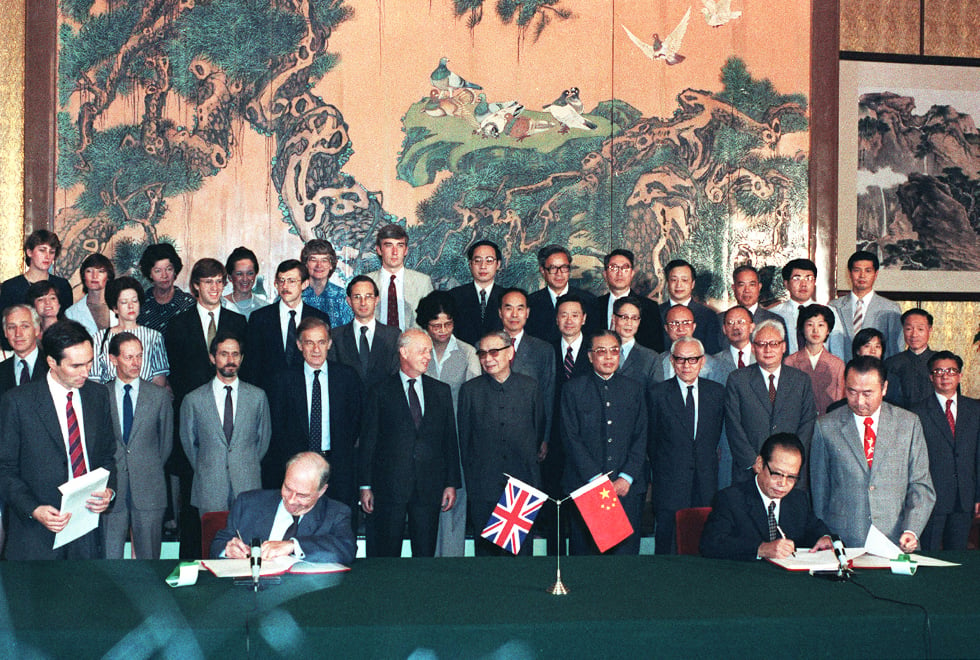
"Zhou Nan, chairman of the Chinese negotiating team, and Sir Richard Evans of the UK sign the draft agreement of the Sino-British Joint Declaration on Sep 26, 1982 in Beijing." P.Y. Tang
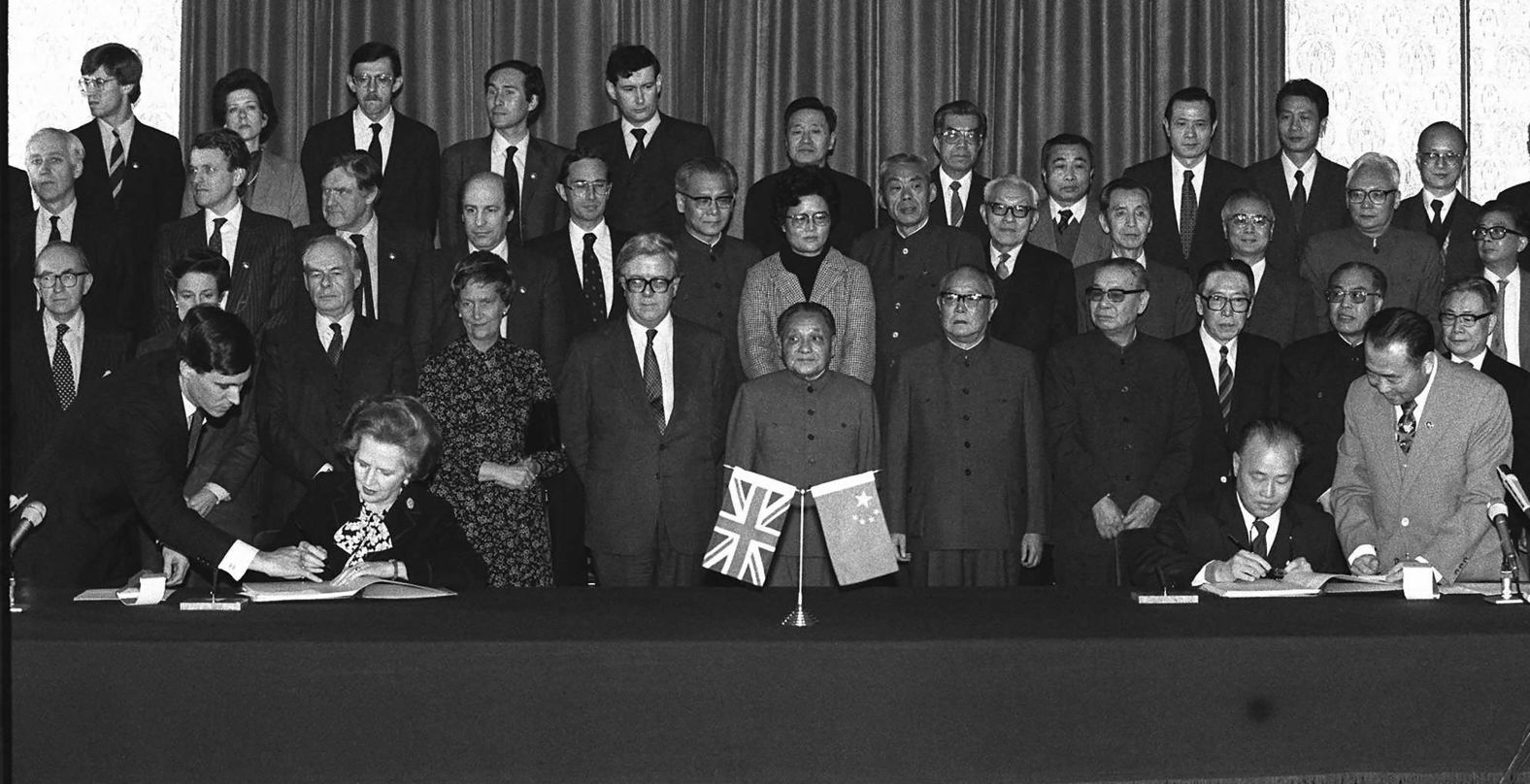
"Thatcher and Chinese Premier Zhao Ziyang sign copies of the Hong Kong handover agreement in Beijing on December 19, 1984. At front center is China's then-top leader, Deng Xiaoping." Neal Ulevich/AP
Japan
After WWII, relations between Japan and China had been nonexistent. After Nixon's visit, a joint communiqué created between Japan and China re-established diplomatic relations and peace between the two countries.
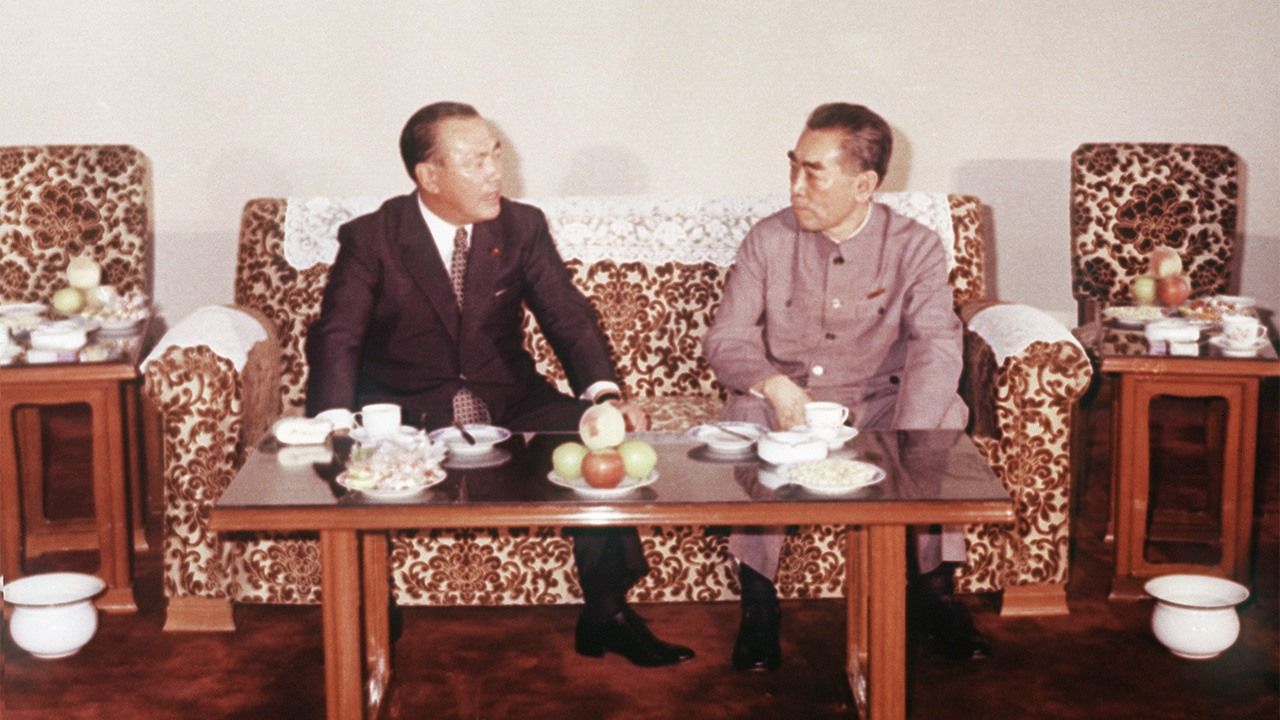
"Prime Minister Tanaka Kakuei (left) and his Chinese counterpart, Zhou Enlai, meet in Beijing for the first Sino-Japanese summit on September 25, 1972." Jiji Press
“The Government of the People's Republic of China welcomes this. Although the social policies of China and Japan differ, the two countries should and can have peaceful and friendly relations. The renewed establishment of diplomatic relations between China and Japan and the development of friendly neighbor relations is not only in line with the fundamental interest of the citizens of both countries, but is also useful for the relaxation of tensions in Asia and for the protection of world peace.”
-Japan’s statements in Joint Declaration

"Japanese Prime Minister Kakuei Tanaka, center left, with Foreign Minister Masayoshi Ohira, far left, and Chinese Premier Zhou Enlai, center right, sign the joint statement to normalize relations between the countries in Beijing on Sept. 29, 1972." AP Photo File
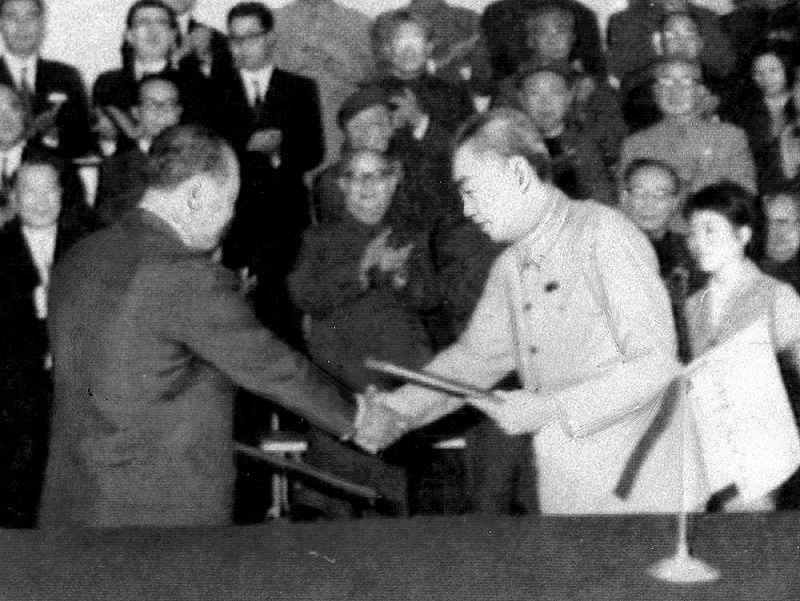
"Kakuei Tanaka and Zhou Enlai shaking hands after signing the Japan-China joint communique", Yomiuri Shimbun file photo
Establishing Trade
World recognition of China allowed for entry into the WTO. These additions increased China's participation in global trade agreements. China was eventually accepted in the global economy.
“I agree with the State position that it continues to be in our interest to support the Republic of China's continued participation in the International Finance Institutions, both because of its importance to the ROC’s diplomatic position and to its international financial position, and because of our desire to avoid injecting political issues into the operations of the International Monetary Fund/International Bank for Reconstruction and Developement.
-Memorandum From John A. Froebe of the National Security Council Staff, August, 1973
The US-China Relations Act granted permanent trade relations between China and America.

"Chinese Trade Minister Shi Guangsheng shakes hands with Charlene Barshefsky, the US Trade Representative, after signing a bilateral agreement on Nov 15, 1999, in Beijing." XU JINGXING/CHINA DAILY
"Authorizes the President to extend nondiscriminatory/normal trade relations treatment to the products of the People's Republic of China, provided, prior to such determination, the President certifies to Congress that the terms and conditions for China's accession to the World Trade Organization are at least equivalent to those agreed between the United States and China on November 15, 1999."
-Division A, Title I: Normal Trade Relations for the People's Republic of China
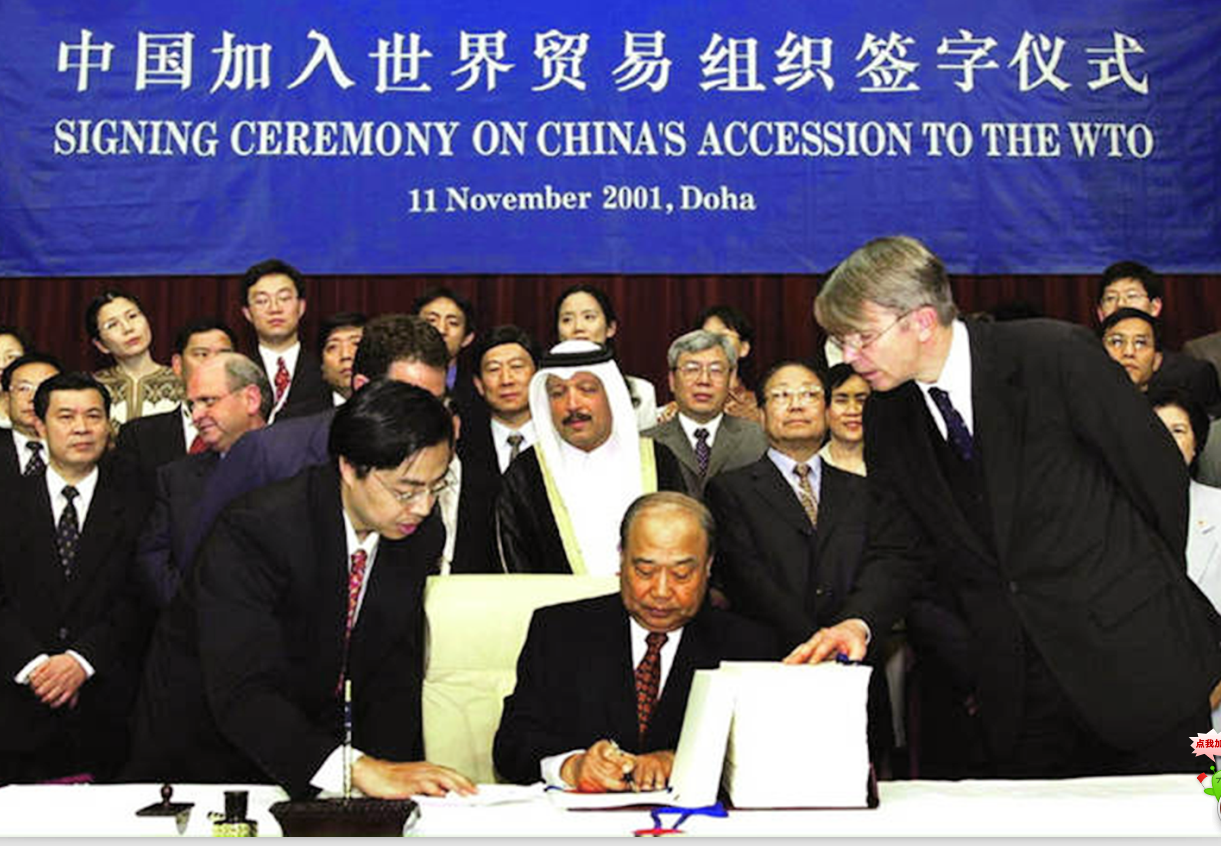
"Signing Ceremony On China's Accession To The WTO, 11 November 2001, Doha." XinHua
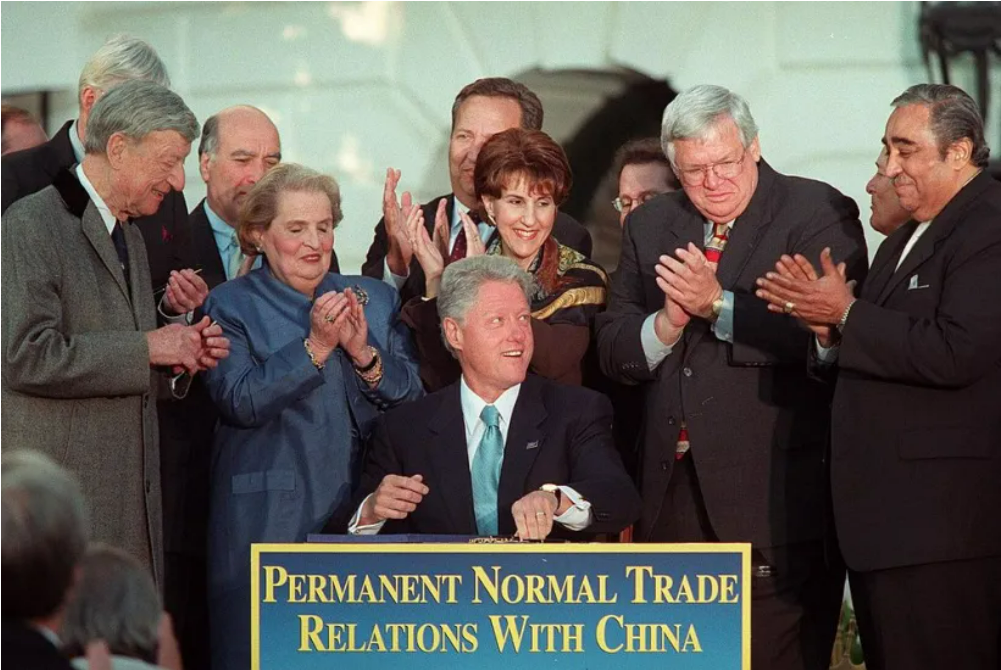
"On October 10, 2000, just around three months before his second and final term in office was to end, President Clinton signed The China Trade Bill into law. That law granted China even further access to American technology." AFP / Mario Tama
Liaison Offices
Following Nixon's visit, both nations worked towards establishing a groundwork for international communications. The creation of Liaison offices initiated communication between the two countries.
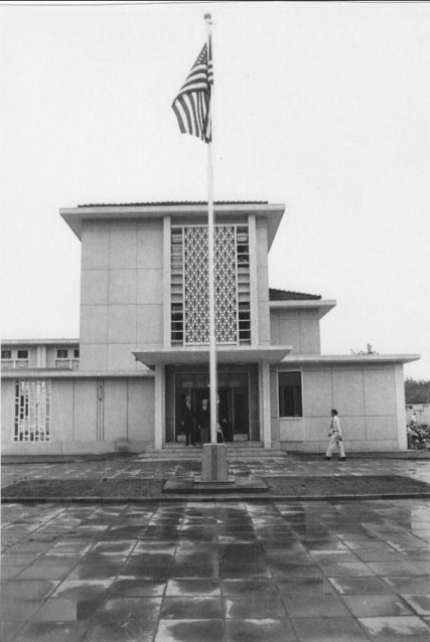
Chinese-US Liaison Office in Washington DC, Richard Nixon Foundation
"Thus, in addition to encouraging a vigorous U.S. international presence, they were anxious to step up our bilateral relationship in every field. They not only accepted our proposal for an American liaison office in Peking, they proposed one of their own in Washington. These non-diplomatic offices will be established by May. Mao and Chou urged greater trade between us. They agreed to a large, specific, and two-way program of exchanges in the scientific, cultural and other fields."
-Memorandum From the President’s Assistant for National Security Affairs(Kissinger) to President Nixon
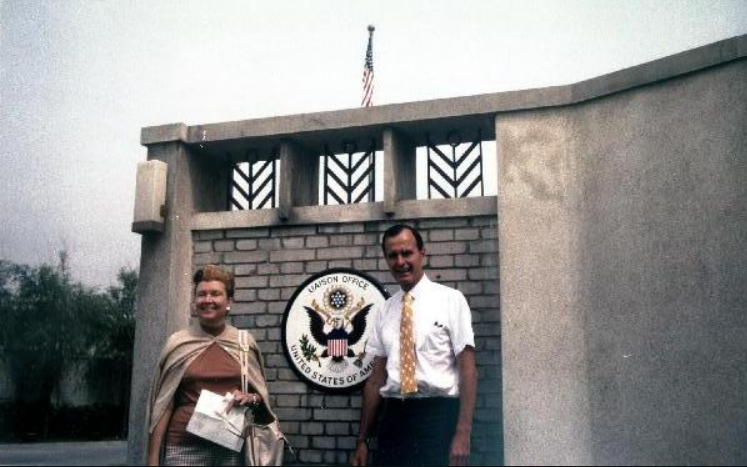
"Chief of US Liaison Office to China, George Bush, in front of the Liaison Office with an unidentified woman, circa 1975" George H.W. Bush Presidential Library and Museum
“The People’s Republic of China is now in the process of establishing a Liaison Office in Washington which will open for business some time in early May. This will provide all agencies of the U.S. Government a more ready contact point with Chinese authorities as the process of normalization of Sino-American relations proceeds.”
-Henry Kissinger's 1972 Memorandum of Conversation
